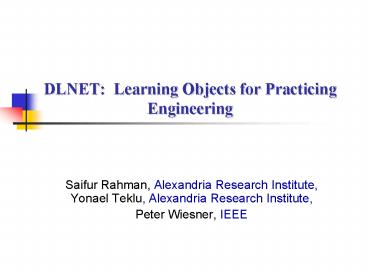DLNET: Learning Objects for Practicing Engineering - PowerPoint PPT Presentation
1 / 16
Title:
DLNET: Learning Objects for Practicing Engineering
Description:
Promotes lifelong learning amongst the engineering community ... Aeronautical and Aerospace, Bioengineering, Chemical, Civil, Electrical, ... – PowerPoint PPT presentation
Number of Views:38
Avg rating:3.0/5.0
Title: DLNET: Learning Objects for Practicing Engineering
1
DLNET Learning Objects for Practicing
Engineering
- Saifur Rahman, Alexandria Research Institute,
Yonael Teklu, Alexandria Research Institute, - Peter Wiesner, IEEE
2
Digital Library Network for Engineers and
Technology DLNET
- PURPOSE
- Promotes lifelong learning amongst the
engineering community - Provides platform for hosting engineering and
technology related content - Is targeted at the practicing engineer and
technologist. - Provides tools for collecting reviewing,
validating and cataloguing new materials. - Provides a portal through which contents can be
both viewed and accessed
3
About DLNET
- A repository of "Learning Objects" (LOs) as well
as a platform for information discovery,
interaction, content-building and distribution
that will support pedagogy and learning in
Engineering and Technology. - Funded by the National Science Digital Library
(NSDL) initiative of the National Science
Foundation - A collaborative effort of four institutions
ASEE, IEEE, Iowa State University (ISU) and
Virginia Tech - The Alexandria Research Institution (ARI) of
Virginia Tech provides overall management and
coordination with NSDL
4
Status of DLNET
- DLNET site and downloadable tools for creating
metadata records and packaging content
completed - Staff at IEEE and Virginia Tech ARI are
populating site with contents - Solicitations for content to IEEE distinguished
lectures and other content providers - Coordination with Open Archives Initiative by
allowing OAI to harvest metadata. - Beta testing of packaging tools in progress
- On-going upgrades and Publication of second
generation of tools and DLNETsite - Goal 1,000 learning objects by 2002
5
About NSDL
- An integrated digital library serving the
collective needs of the broad STEM educational
communityNetwork of learning resources and
environments. - A digital learning place that encourages and
supports users in their efforts to create,
discover, explore, and interact with digital
resources - NSDL consists of a federation of digital
libraries and collections in all aspects of STEM.
- Collaboration through a Core Integration System
(CIS) for governance and common specifications
regarding technologies and services for
interoperability, communication, and collections
management.
6
DLNET Collections Scope
- DLNET is a peer-reviewed repository of Learning
Objects" and platform for information discovery,
interaction, content-building and distribution
that will support pedagogy and learning in
engineering and technology. - DLNET aims to (a) facilitate lifelong-learning
essential to the professional development of
practicing engineers and technologists, and (b)
support innovative pedagogical approaches that
will benefit students and educators. - DLNET provides upated taxonomy and tools to
enable engineers to submit content
7
DLNET Collections Areas/Categorization
- Engineering and technology areas such as
- Aeronautical and Aerospace, Bioengineering,
Chemical, Civil, Electrical, Environmental,
Industrial and Systems, Materials Science and
Engineering, Mechanical, and Mining. - Subject areas common to all engineering such as
- Information and Communication Technologies,
Computational Methods, Engineering Education and
Professional Development have been included. - Content materials in other engineering and
technology areas - Management, education, project management
8
Taxonomy
- A three-level listing from general to particular.
- Taxonomy, patterned after INSPEC, is designed for
web use - Evolves depending on submissions and usage
- Each level in the taxonomy has been assigned a
unique ID used throughout DLNET.
9
Taxonomy 3 levels
- A learning resource about Distribution
Transformers is placed in the DLNET taxonomy
under - ELECTRICAL ENGINEERING
- ENERGY AND POWER SYSTEMS
- SUBSTATIONS, SWITCHGEAR AND TRANSFORMERS
10
Definition of Learning Object
- Definition
- A learning object (LO) is defined as a
structured electronic resource that encapsulates
high quality information in a manner that
facilitates pedagogy. It has a stated objective
and a designated audience. It has ownership and
associated intellectual property. - Learning Objects can include text, streaming a-v,
graphs, applets, course modules, databases,
simulations, equation editors, etc
11
Characteristics of LO
- Learning
- The LO as an independent entity i.e. as an
individual topic - Ad-hoc learning via progressive traversing of LOs
- Object
- The electronic resources - the actual physical
files - Analogous to objects used in object-oriented
modeling (OOM) - Ownership
- The intellectual property of the LO
- Gaining recognition, feedback via peer-review and
wide distribution of the content - Quality
- Pedagogical effectiveness
- Subject matter accuracy
- Production value appropriateness
- Proper technical behavior
12
LO Development Tool
- Three Tasks
- Metadata collection
- Provide well defined fields where user can enter
the data. - Two options user direct input or pre-defined
fields - Resource Validation
- Verify the structural integrity of the resource
- Web-based LO
- Non-web (browser supported) LO
- Content Packaging
- Bundles together the two components in a
prescribed fashions to allow convenience of
re-use and delivery - Standards IMS Metadata (v1.2) and Content
Packaging (v1.1.1)
13
Tool Programming and Interface
- Hardware/Software
- JAVA client-based application (operating system
independent code) - Steps in LO Creation using the Tool
14
DLNET Website and HW/SW
- Hardware/Software
- Core server-side functionality is provided using
java components such as java Beans, Servlets and
JSP technologies hosted by a java servlet engine
provided by apache (Tomcat).
Submit the LO for review and distribution via
logging in to the DLNET website
15
Summary of DLNET Features
- Taxonomy three tiered for browsing, classifying
learning objects, determining areas of interest - Hosting of LO object or URL
- Complete Package Interchange File (PIF) conforms
IMS/IEEE P1484 - Downloadable tools for packaging
- Online peer review process
- My DLNET Page ability to track ones own
transactions (downloads, uploads, reviews) - Portal conforms to NSDL requirements
- Compliance with OAI (Open Archives Initiative)
Protocols for Metadata Harvesting
16
Future
- Enriching the collection
- Link to other Engineering Collections
- Annotated User Reviews
- Process for updating taxonomy
- User education (I.e. online searching)
- Pathfinders































